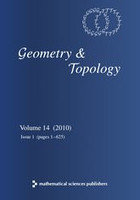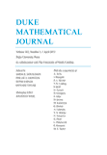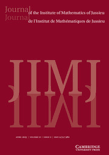
Communications in Number Theory and Physics
Scope & Guideline
Exploring the Symbiosis of Number Theory and Physics
Introduction
Aims and Scopes
- Interdisciplinary Research:
The journal emphasizes the fusion of number theory and various branches of physics, particularly quantum physics, string theory, and algebraic geometry, fostering a collaborative environment for researchers from both fields. - Modular Forms and Invariants:
A significant focus is placed on modular forms, their properties, and their applications in physics, including the study of invariants related to Calabi-Yau manifolds and other geometric structures. - Quantum Geometry and Topology:
Research on quantum geometrical frameworks, including spectral geometry and topological recursion, is a core aspect, particularly how these concepts relate to physical theories and models. - Algebraic Structures and Cohomology:
The journal covers studies involving algebraic structures such as cohomological Hall algebras and derived categories, which are essential in understanding the mathematical underpinnings of physical models. - Numerical and Experimental Methods:
There is an increasing incorporation of numerical methods and computational experiments in the analysis of mathematical models, especially in the context of partition functions and invariants.
Trending and Emerging
- Quantum Modular Forms:
There is a noticeable increase in research concerning quantum modular forms, reflecting their significance in understanding modularity and their applications in various physical contexts, including quantum invariants. - Geometric and Topological Invariants:
The exploration of geometric and topological invariants, particularly in relation to Calabi-Yau manifolds and their moduli spaces, is gaining traction, linking deep mathematical concepts with physical implications. - Stochastic and Random Field Theories:
Emerging interest in stochastic processes and random fields is evident, with researchers investigating their applications in quantum gravity and statistical physics, suggesting a growing interdisciplinary approach. - Resurgence and Stokes Phenomena:
Research on resurgence, Stokes phenomena, and their applications in quantum field theory and string theory is on the rise, indicating a trend towards understanding complex analytical structures that arise in physical theories. - Higher-Dimensional Algebraic Structures:
There is a burgeoning interest in higher-dimensional algebraic structures, including their implications for derived categories and cohomological methods, reflecting a shift towards more abstract mathematical frameworks.
Declining or Waning
- Classical Diophantine Equations:
While traditional Diophantine equations have been a staple in number theory, recent publications suggest a decline in focus on classical problems, with more emphasis shifting toward modern algebraic and geometric approaches. - Low-Dimensional Topology:
Topics related to low-dimensional topology, such as certain invariants in three-manifolds, appear less frequently, indicating a potential waning interest in these areas compared to more abstract algebraic and quantum geometric studies. - Elementary Number Theory:
Research articles rooted in elementary number theory concepts, such as basic properties of integers and simple congruences, have decreased, as the journal leans towards more complex and abstract theories. - Traditional Quantum Field Theory:
While quantum field theory remains a crucial topic, the focus on its traditional formulations appears to be declining in favor of more contemporary approaches that integrate algebraic and geometric perspectives.
Similar Journals

BULLETIN OF THE LONDON MATHEMATICAL SOCIETY
Exploring Innovative Research in MathematicsThe BULLETIN OF THE LONDON MATHEMATICAL SOCIETY, published by Wiley, is a distinguished journal that serves as a vital resource in the field of mathematics. With its ISSN 0024-6093 and E-ISSN 1469-2120, this journal has consistently provided a platform for innovative research and scholarly discourse since its inception in 1969. Recognized for its quality, it currently holds an impressive Q1 ranking in the mathematics category, a testament to its significance in disseminating influential findings and trends in the mathematical sciences. Researchers and practitioners can rely on the BULLETIN for its comprehensive coverage of both theoretical and applied mathematics, which caters to a diverse audience ranging from professionals to students alike. Though it does not currently offer Open Access options, its articles can be accessed through institutional subscriptions, ensuring that significant works reach the academic community effectively. With contributions that span over five decades, the journal continues to shape mathematical research and inspire future advancements in the discipline.

Mediterranean Journal of Mathematics
Bridging Theory and Practice in the World of MathematicsThe Mediterranean Journal of Mathematics, published by SPRINGER BASEL AG, is a prominent platform dedicated to the advancement of mathematical research and education. Since its inception in 2004, this journal has been pivotal in disseminating high-quality research across various fields of mathematics, currently holding a notable Q2 ranking in the miscellaneous mathematics category as of 2023. With its ISSN 1660-5446 and E-ISSN 1660-5454, the journal enjoys a respected position in the academic community, evident by its Scopus rank of 129 out of 399 in General Mathematics, placing it in the 67th percentile. While primarily a subscription-based journal, it remains committed to providing a comprehensive resource for researchers, professionals, and students, fostering dialogue and exploration within the mathematical sciences. The Mediterranean Journal of Mathematics, based in Basel, Switzerland, continues to contribute significantly to the evolution of mathematical theory and practice, marking its relevance as we approach its 20th anniversary in 2024.

GEOMETRY & TOPOLOGY
Exploring the Boundaries of Mathematical ThoughtGeometry & Topology is a leading journal in the field of mathematics, focusing on the intricate relationships between geometric structures and topological spaces. Published by Geometry & Topology Publications in the United Kingdom, this prestigious journal boasts an impressive ranking, placing it in the Q1 quartile for Geometry and Topology as of 2023, with a notable Scopus rank of #13 out of 106, indicating its significant impact within the discipline (88th percentile). With publication years spanning from 1997 to 2024, the journal serves as a vital platform for disseminating high-quality research, fostering advances in both theoretical and applied aspects of the field. While it does not currently operate under an Open Access model, it nevertheless attracts the attention of a diverse audience, including researchers, academics, and students eager to explore innovative methodologies and findings in geometry and topology. The journal’s commitment to excellence makes it an essential resource for anyone passionate about mathematical research.

RENDICONTI DEL SEMINARIO MATEMATICO DELLA UNIVERSITA DI PADOVA
Connecting mathematicians through accessible, impactful research.RENDICONTI DEL SEMINARIO MATEMATICO DELLA UNIVERSITA DI PADOVA, published by the European Mathematical Society, stands as a notable open-access journal with a rich history in disseminating research across various domains of mathematics. With an ISSN of 0041-8994 and E-ISSN 2240-2926, this journal has embraced open access since 2023, significantly enhancing its visibility and accessibility to a global audience. Situated in Germany, its publishing house is based at Technical University Berlin, which emphasizes its academic roots and dedication to fostering mathematical research. The journal features a quartile ranking of Q3 across multiple categories including Algebra and Number Theory, Analysis, Geometry and Topology, and Mathematical Physics as of 2023, indicating a vibrant contribution to the field, despite its challenge in specific rankings. Researchers, professionals, and students alike will find in this journal a platform for innovative ideas and significant findings that are crucial to the evolution of modern mathematics.

Symmetry Integrability and Geometry-Methods and Applications
Pioneering Research in Symmetry and GeometrySymmetry Integrability and Geometry-Methods and Applications is a prominent open-access journal published by the NATIONAL ACADEMY OF SCIENCES OF UKRAINE, INSTITUTE OF MATHEMATICS, dedicated to advancing research in the fields of Analysis, Geometry and Topology, and Mathematical Physics. Since its inception in 2005, the journal has provided an esteemed platform for scholars from around the globe to share their innovative findings and methodologies, contributing to our understanding of complex mathematical concepts. With an impressive Q2 ranking in all three mathematical categories as per the 2023 Scopus rankings, the journal positions itself as a key resource for researchers seeking high-quality, peer-reviewed content. As a fully open-access publication, it ensures that research is readily available to a wide audience, fostering collaboration and knowledge exchange in the mathematical sciences.

Publications Mathematiques de l IHES
Leading the charge in mathematics with exclusive collections.Publications Mathematiques de l IHES, published by SPRINGER HEIDELBERG, stands as a premier journal in the field of mathematics, particularly renowned for its contributions to general mathematics and related disciplines. With a distinguished ranking of 7 out of 399 in Scopus and a remarkable position within the 98th percentile, this journal underscores its significance in disseminating high-quality mathematical research. Active since 1959 and continuing through to 2024, the journal has established itself as a vital platform for scholars, providing rich insights and advancements in theoretical and applied mathematics. Despite being a non-open access journal, its exclusive collections remain widely respected in academia, particularly within Q1 quartile rankings in Mathematics (miscellaneous). With comprehensive and rigorous peer-reviewed articles, Publications Mathematiques de l IHES is essential reading for researchers, professionals, and students eager to engage with cutting-edge mathematical developments.

MICHIGAN MATHEMATICAL JOURNAL
Advancing Mathematical Frontiers with Rigorous ResearchThe MICHIGAN MATHEMATICAL JOURNAL is a prestigious and influential publication in the field of mathematics, founded by the University of Michigan. With an ISSN of 0026-2285 and an E-ISSN of 1945-2365, this journal is recognized for its high-quality research and has achieved a commendable Q1 ranking in the category of Mathematics (miscellaneous) as of 2023. Published by the esteemed Michigan Mathematical Journal, it provides a platform for the dissemination of innovative mathematical theories and findings, playing a crucial role in advancing knowledge and scholarship within the mathematical community. With coverage spanning from 1996 to 2024, the journal emphasizes rigorous theoretical development and fosters collaboration among researchers, professionals, and students alike. While not an open-access journal, its contributions are invaluable for those looking to stay abreast of cutting-edge mathematical research.

DUKE MATHEMATICAL JOURNAL
Innovating Ideas, Transforming TheoriesDUKE MATHEMATICAL JOURNAL, published by DUKE UNIVERSITY PRESS, stands as a premier journal in the field of Mathematics, with an esteemed reputation reflected in its Q1 ranking in Mathematics (miscellaneous) for 2023 and its status as one of the top 50 journals in General Mathematics according to Scopus rankings. Since its inception in 1935, this journal has committed to publishing high-quality research that pushes the boundaries of mathematical knowledge and theory. With a broad scope that encompasses various areas within mathematics, the journal serves as a vital platform for disseminating innovative ideas and findings. Although it does not offer Open Access options, its rigorous peer-review process ensures the integrity and excellence of the work it publishes, making it an essential resource for researchers, professionals, and graduate students aiming to contribute to or stay informed about the rapid advancements in this dynamic field. For more information, visit its office at 905 W MAIN ST, STE 18-B, DURHAM, NC 27701.

Journal of the Institute of Mathematics of Jussieu
Pioneering Research in the Heart of MathematicsJournal of the Institute of Mathematics of Jussieu, published by Cambridge University Press, is a leading academic journal that has established itself as a vital resource in the field of mathematics. With an impressive impact factor and a ranking in the top quartile (Q1) of miscellaneous mathematics, the journal serves as a platform for high-quality research from both established scholars and emerging researchers. Spanning from 2002 to 2024, the journal aims to foster collaboration and innovation in the mathematical community by publishing original research articles, reviews, and critical discussions on a wide range of mathematical topics. Although the journal does not offer open access, it remains widely accessible through various academic institutions and libraries, ensuring that critical advancements in mathematics are shared with a global audience. Located in the United Kingdom at the prestigious Cambridge campus, the journal reflects the rigorous standards of its publisher and the rich academic tradition of its home institution.

Hiroshima Mathematical Journal
Exploring the Depths of Algebra, Analysis, and BeyondThe Hiroshima Mathematical Journal, published by Hiroshima University, Graduate School of Science, serves as a prominent platform for disseminating high-quality research in the field of mathematics. Established in 1959, the journal has been an integral part of the mathematical community, focusing on areas such as Algebra, Number Theory, Analysis, and Geometry and Topology. Although currently classified in Q4 quartile rankings within its categories, the journal is committed to advancing mathematical knowledge and fostering scholarly dialogue. Its accessibility, combined with its long-standing history, makes it an essential resource for researchers, professionals, and students dedicated to exploring and enhancing the mathematical sciences. For those interested in contributing or accessing cutting-edge research, the Hiroshima Mathematical Journal continues to uphold its mission of excellence in mathematical scholarship.